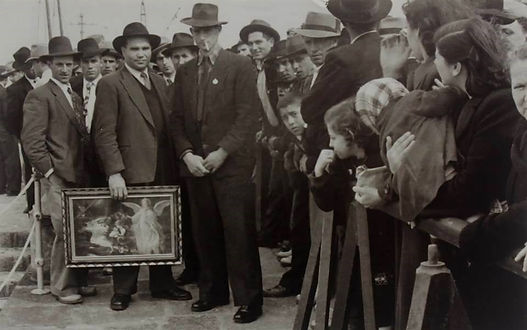
1954, THE MICAELENSE YEAR

José-Louis Jacome, July 20, 2020
The First Contingent
Monday March 22, 1954 is certainly an historic day for São Miguel. Ponta Delgada, the capital of the island, was experiencing unusual activity at the time, something that had not been seen since the multiple departures of the White Star and the Fabre Line at the beginning of the century. Several members of my family had left the island at the time. The atmosphere around the harbor was full of emotions. Thousands of people invaded the Molhe Salazar pier to say a last goodbye, to hug, to cry once more, perhaps to see for the last time a family member, a friend leaving today. A first contingent of 330 emigrants left in the afternoon aboard the Homeland. They were received by Governor Aniceto dos Santos at the Palácio da Conceicão around noon. Members of their families and several of the emigrants who will follow in the next departures scheduled for April 23 and 27 were also invited. After the ceremony, The Governor and other dignitaries headed for the port, accompanying the emigrants. The heads of the Canadian mission, Messrs Odillon Cormier, Percy Colville and Dr. Pierre Bélanger were present. Unlike in the 1953 departures, medical examinations and authorizations were completed in São Miguel. The President of the Junta Nacional da Émigração, Colonel Antonio Manuel Batista and his colleagues Dr. José Dias Henriques and Inspector Mario Ferreira da Costa were among the VIPs.

330 Azoreans in front of the Palácio da Conceicão in Ponta Delgada, before leaving to Canada on March 22, 1954.



An article from the newspaper Correio dos Açores, March 24, 1954, describing the historical event.
Photos: Museu da Emigração Açoriana
That day, March 22, I was almost 5 years old. I don't know if I was there with my father at the port of Ponta Delgada. He may have gone there to greet several friends who were leaving in the afternoon including José da Costa and Dinis Maciel. He would join them the following month in Canada. I have always had a vague image well stuck to the farthest reaches of my memory. I see a huge ship, all lit up, anchored far away from the port. I never managed to clarify this image. That day, the Homeland, for some reason I don't know, was unable to dock at the pier. It anchored offshore. The Azorean emigrants had to access it packed in small boats. The first left the pier around 2:30 p.m. The image is vague but I am sure that one day in 1954, I was in my father's arms and I saw an illuminated ship anchored near the horizon.
I don't know if it was March 22 or April 23, the day my father left? On March 22, the Homeland set out for Halifax around 7 p.m.
Farewell messages from 2 emigrants in the same article.


About the author
Born in São Miguel and living in Montreal since 1958, I published a book in 2018 about Azorean immigration to Canada in the 1950s. “De uma ilha para outra” was published in Portuguese and French. The book and an exhibition that accompanies it were presented in Montreal, São Miguel, Toronto and Boston. The book is sold in Montreal, Toronto and São Miguel, and through my Website. I continue to publish information and stories relating to the first big wave of Azorean and Portuguese immigration to Canada in the 1950s through my Website jljacome.com and my Facebook page D’une île à l’autre.

